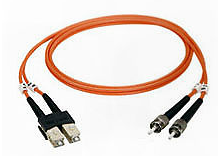- Related articles
- About Transceiver & Cisco Transceiver Modules
- What is WDM transceiver?
- All Cisco ONS-SC-GE-LX's information (List price, Specs, Datasheet PDF, Compatibility matr
- All Cisco DWDM-X2-42.14's information (List price, Specs, Datasheet PDF, Compatibility mat
- All Cisco DWDM-SFP10G-61.41's information (List price, Specs, Datasheet PDF, Compatibility
- What the IEEE Designation for the Gigabit Ethernet Standard is?
- Optical Transceivers for Cisco WS-C2960XR-24TD-I Switch
- What is wave division multiplexing?
- All Cisco XENPAK-10GB-LW's information (List price, Specs, Datasheet PDF, Compatibility ma
- Optical Transceivers for Cisco SF300-24PP-K9-EU Switch

Introduction
Connecting to a computer network with fiber optic cables requires sufficient knowledge. Therefore, it is very important to understand the procedure of doing it. First and foremost you should plug in the fiber optic cable into the converter. Ensure the USB or cable is well fitted in the computer port. Then turn on the computer on the network.

Discussion
Position all the devices that will be included in the network. The hubs and switches should be placed near the main computer and the wall outlet (for integrated fiber in the loop, IFITL connections). Connect the computer to the wall outlet using the cable and connect the hubs and routers to the computer.
Add a fiber optic cable to the hub or router and connect it to a second computer to be added to the network. Ensure that there's enough slack in the cable so it's not too tight and easily unplugged. Secure the cables with ties.
A media converter is necessary for devices that have no fiber optic outlet. This converter changes the light pulses into electricity. Plug this into the computer with a USB or Ethernet cable. Plug in any workstation without a fiber optic outlet into the converter.
Turn on all the devices and computers on the network.
Install additional software and drivers on devices if needed.
Maintaining a Computer Network with Fiber Optic Cables
A simple indoor computer network won't need a lot of upkeep. In fact, fiber optic cables were designed to be maintained easily. Just ensure that none of the cables are disconnected or damaged. Cables should be neat and tied together to prevent accidents, and of course, should be kept away from young kids and pets. Fiber optic cables can experience slow or unreliable connections due to excess dust, scratches, or even humidity. An inexpensive laser pointer can help check if the cable is working. Point the laser at one end of the cable and see if the other end lights up. If it does, this means the cable is conducting light properly. If not, the cable will have to be cleaned or replaced. Networks that have to run cables outdoors (perhaps to another room or building) will need to be checked periodically. Fallen tree branches, passing vehicles, or even small animals can damage fiber optic cables.
Conclusion
How you connect the fiber optic cable to your computer determines the quality of the data. Therefore, you should ensure that you have done the correct connection. However, the process is very simple and easy to understand.





































































